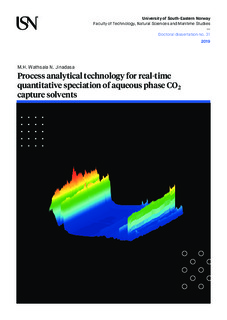| dc.contributor.author | Jinadasa, Wathsala | |
| dc.date.accessioned | 2019-03-29T13:48:32Z | |
| dc.date.available | 2019-03-29T13:48:32Z | |
| dc.date.issued | 2019-04-08 | |
| dc.identifier.isbn | 978-82-7206-523-1 | |
| dc.identifier.issn | 2535-5252 | |
| dc.identifier.uri | http://hdl.handle.net/11250/2592531 | |
| dc.description.abstract | Dependency on fossil fuel energy systems is unavoidable until there is a complete shift to alternative energy systems which have no/less impact for global warming. Rapid deployment of carbon capture and sequestration (CCS) projects for large scale power plants and industrial sectors is a timely need to follow climate change mitigation action by reduced CO2 gas emission. It is logically and scientifically understood that more amine based CO2 capture plants should be implemented and the existing facilities should be scaled up. A properly established reliable in-situ solvent analysis system can speed up this movement. From laboratory to industrial scale, process analytical tools have replaced most of traditional chemical analysis methods because of their massive chemical information packed in a single measurement, fast response, real- time / in-situ use, time saving, minimal errors in sample handing and quick identification of process related problems and ability to integrate with process control. Raman spectroscopy combined with multivariate analysis is a proven methodology for the determination of various chemical concentration profiles in chemical solvents for CO2 capture.
Seven multivariate regression models were developed under this study to predict species concentrations of carbonate, bicarbonate, sum of carbonate and bicarbonate, carbamate, protonated amine, free amine and CO2 loading in an MEA-CO2-H2O system based on their Raman spectra. Reference measurements were collected from 13C NMR spectroscopy for individual chemical analysis which were used for the regression. The model performance was demonstrated in continuous operation at USN CO2 rig and PACT Facility in Sheffield and the initial laboratory based model methodology was further updated to yield better predictability for each plant. The reliability of the predicted speciation were assessed in several ways both theoretically and experimentally. In addition, Raman spectroscopic measurements acquired during PACT campaign and the corresponding offline titration measurements were used to develop a new calibration model to predict amine weight percentage and sum of protonated amine and free amine in the chemical system. A graphical user interface was built in Labview to make a user friendly environment for monitoring in-situ speciation. CO2 loading was determined when 3-amino-1-propanol, 3-dimethylamino-1-propanol and methyl diethanolamine were used as CO2 capture solvents using Raman spectroscopy with multivariate modelling to show the method applicability in other solvents except MEA. The combination of Raman spectroscopy, chemometrics use for data treatment and variable selection, PLSR regression, reference analysis by 13C NMR spectroscopy, and test set validation were the key contributors to obtain reliable regression models in this study. In addition, concepts of process analytical technology such as elements of PAT implementation, design of experiments, process sampling and calibration transfer procedures were adhered throughout the plant campaigns and they contributed to achieve higher accuracy and precision from the developed methods. | nb_NO |
| dc.language.iso | eng | nb_NO |
| dc.publisher | University of South-Eastern Norway | nb_NO |
| dc.relation.ispartofseries | Doctoral dissertations at the University of South-Eastern Norway;31 | |
| dc.relation.haspart | Paper A: Jinadasa, M.H.W.N., Jens, K.-J. & Halstensen, M.: In-situ Monitoring Method for CO2 Capture Process - Complete Liquid Speciation. Accepted for publication in Journal of Raman Spectroscopy | nb_NO |
| dc.relation.haspart | Paper B: Jinadasa, M.H.W.N., Jens, K.-J., Øi, L.E. & Halstensen, M.: Raman Spectroscopy as an Online Monitoring Tool for CO2 Capture Process: Demonstration Using a Laboratory Rig. Energy Procedia 114, 2017, 1179-1194. https://doi.org/10.1016/j.egypro.2017.03.1282 | nb_NO |
| dc.relation.haspart | Paper C: Jinadasa, M.H.W.N., Jens, K.-J. & Halstensen, M.: Process Analytical Technology for CO2 Capture. In: Carbon Dioxide Chemistry, Capture and Oil Recovery, 2018. ISBN 978-1-78923-574-6. https://doi.org/10.5772/intechopen.76176 | nb_NO |
| dc.relation.haspart | Paper D: Jinadasa, M.H.W.N., Jens, K.-J., Pfeiffer, C., Ronasi, S., Solar, C.B. & Halstensen, M.: Principal Component Analysis Applied to CO2 Absorption by Propylene Oxide and Amines. Linköping Electronic Conference Proceedings, Proceedings of The 9th EUROSIM Congress on Modelling and Simulation, EUROSIM 2016, The 57th SIMS Conference on Simulation and Modelling SIMS 2016, pp. 207-213, 2018. https://doi.org/10.3384/ecp17142207 | nb_NO |
| dc.relation.haspart | Paper E: Jinadasa, M.H.W.N., Jens, K.-J. & Halstensen, M.: PCA Coupled Raman Spectroscopy as a Rapid Simple Approach for Screening CO2 Absorption. Manuscript. Not available in USN Open Archive | nb_NO |
| dc.relation.haspart | Paper F: Jinadasa, M.H.W.N., Chandra, K.A. & Halstensen, M.: System Development for On-line Monitoring using Raman Spectroscopy for CO2 Absorption by MEA. Linköping Electronic Conference Proceedings, The 59th International Conference of Scandinavian Simulation Society, SIMS 2018, pp. 328-333, 2018. https://doi.org/10.3384/ecp18153328 | nb_NO |
| dc.relation.haspart | Paper G: Halstensen, M., Jilvero, H., Jinadasa, M.H.W.N. & Jens, K.-J., Øi, L.E. & Halstensen, M.: Equilibrium Measurements of the NH3-CO2-H2O System: Speciation Based on Raman Spectroscopy and Multivariate Modeling. Journal of Chemistry, 2017. https://doi.org/10.1155/2017/7590506 | nb_NO |
| dc.rights.uri | http://creativecommons.org/licenses/by-nc-sa/4.0/deed.en | |
| dc.title | Process analytical technology for real-time quantitative speciation of aqueous phase CO2 capture solvents | nb_NO |
| dc.type | Doctoral thesis | nb_NO |
| dc.description.version | publishedVersion | nb_NO |
| dc.rights.holder | © 2019 M.H. Wathsala N. Jinadasa, except otherwise stated | nb_NO |
| dc.subject.nsi | VDP::Teknologi: 500::Kjemisk teknologi: 560::Kjemisk prosessteknologi: 562 | nb_NO |
| dc.rights.license | © The Author, except otherwise stated | |

